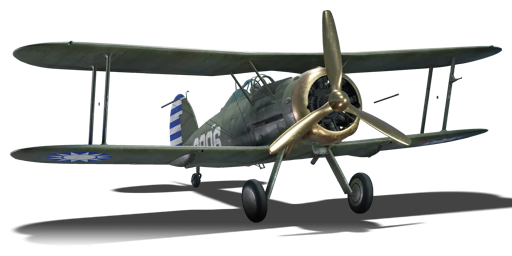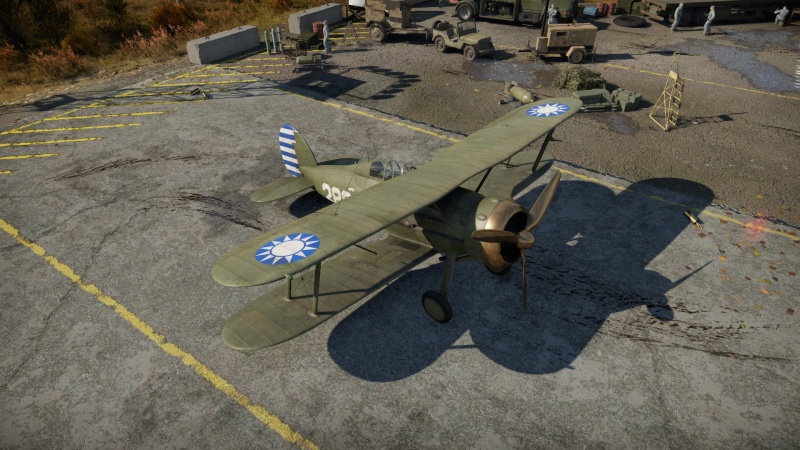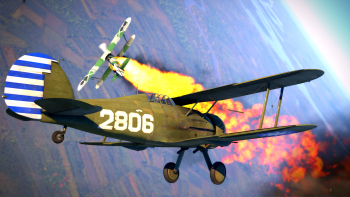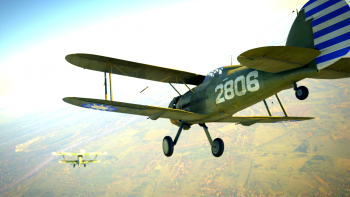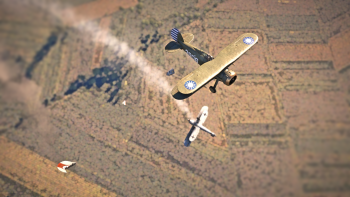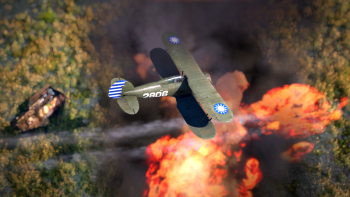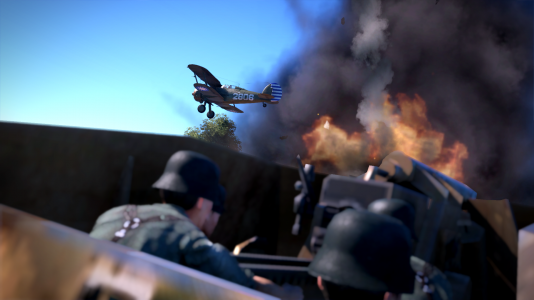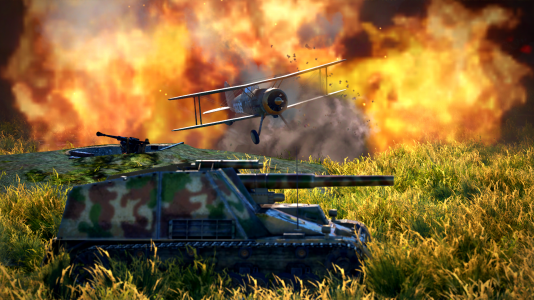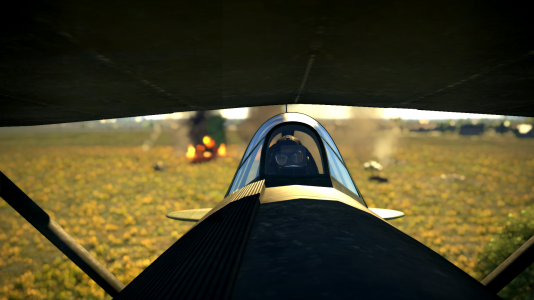Difference between revisions of "Gladiator Mk I (China)"
m (Tag: Visual edit) |
|||
| (11 intermediate revisions by 6 users not shown) | |||
| Line 1: | Line 1: | ||
| − | |||
| − | |||
| − | |||
| − | |||
{{About | {{About | ||
| about = fighter '''{{PAGENAME}}''' | | about = fighter '''{{PAGENAME}}''' | ||
| usage = other versions | | usage = other versions | ||
| link = Gladiator (Family) | | link = Gladiator (Family) | ||
| + | }} | ||
| + | {{Specs-Card | ||
| + | |code=gladiator_mk1_china | ||
| + | |images={{Specs-Card-Image|GarageImage_{{PAGENAME}}.jpg}} | ||
}} | }} | ||
== Description == | == Description == | ||
<!-- ''In the description, the first part should be about the history of and the creation and combat usage of the aircraft, as well as its key features. In the second part, tell the reader about the aircraft in the game. Insert a screenshot of the vehicle, so that if the novice player does not remember the vehicle by name, he will immediately understand what kind of vehicle the article is talking about.'' --> | <!-- ''In the description, the first part should be about the history of and the creation and combat usage of the aircraft, as well as its key features. In the second part, tell the reader about the aircraft in the game. Insert a screenshot of the vehicle, so that if the novice player does not remember the vehicle by name, he will immediately understand what kind of vehicle the article is talking about.'' --> | ||
| − | |||
| − | |||
The '''{{Specs|name}}''' is a rank {{Specs|rank}} Chinese fighter {{Battle-rating}}. It was introduced in [[Update 1.91 "Night Vision"]]. | The '''{{Specs|name}}''' is a rank {{Specs|rank}} Chinese fighter {{Battle-rating}}. It was introduced in [[Update 1.91 "Night Vision"]]. | ||
| + | |||
| + | This aircraft has the camouflage of American Volunteer pilot Arthur Chin's Gladiator, No.2806. Arthur Chin flew this aircraft in the Second Sino-Japanese war, scoring 6.5 aerial victories in it. He would be recognized as America's first ace of WWII. | ||
== General info == | == General info == | ||
=== Flight performance === | === Flight performance === | ||
{{Specs-Avia-Flight}} | {{Specs-Avia-Flight}} | ||
| − | ''Describe how the aircraft behaves in the air. Speed, manoeuvrability, acceleration and allowable loads - these are the most important characteristics of the vehicle.'' | + | <!--''Describe how the aircraft behaves in the air. Speed, manoeuvrability, acceleration and allowable loads - these are the most important characteristics of the vehicle.''--> |
{| class="wikitable" style="text-align:center" width="70%" | {| class="wikitable" style="text-align:center" width="70%" | ||
| Line 61: | Line 61: | ||
! Combat !! Take-off !! Landing !! + !! - | ! Combat !! Take-off !! Landing !! + !! - | ||
|- | |- | ||
| − | | {{Specs|destruction|body}} || {{Specs|destruction|gear}} || N/A || | + | | {{Specs|destruction|body}} || {{Specs|destruction|gear}} || N/A || 469 || 320 || ~11 || ~5 |
|- | |- | ||
|} | |} | ||
| Line 115: | Line 115: | ||
The Gladiator Mk Is arrived in China with the standard 7.7 mm Browning machine guns, two of which were mounted on each side of the pilot within arm's reach and the other two were mounted one under each side of the lower wing. It is important for pilots of this aircraft to determine at what distance they typically engage enemy aircraft at as convergence of the machine guns is a necessity to manage to effectively put as many bullets as possible into the enemy fighter. Typically in biplanes, a closer convergence setting of 100 to 250 m is best for close-in fighting, typically as one gets farther out from there, bullets lose some of their punch. | The Gladiator Mk Is arrived in China with the standard 7.7 mm Browning machine guns, two of which were mounted on each side of the pilot within arm's reach and the other two were mounted one under each side of the lower wing. It is important for pilots of this aircraft to determine at what distance they typically engage enemy aircraft at as convergence of the machine guns is a necessity to manage to effectively put as many bullets as possible into the enemy fighter. Typically in biplanes, a closer convergence setting of 100 to 250 m is best for close-in fighting, typically as one gets farther out from there, bullets lose some of their punch. | ||
| − | Many ace pilots from all sides of the war stated that when the enemy filled the windscreen, there was no way you could not hit, thereby guaranteeing a hit and conserving ammunition. The Gladiator Mk I does not have the machine-gun firing speed of those found on some | + | Many ace pilots from all sides of the war stated that when the enemy filled the windscreen, there was no way you could not hit, thereby guaranteeing a hit and conserving ammunition. The Gladiator Mk I does not have the machine-gun firing speed of those found on some Soviet biplanes as it is necessary to synchronize the firing of the guns in the fuselage to fire through the propeller arc. With 2,000 rounds of ammunition distributed between all four machine guns, it is recommended to fire in short bursts, mainly to prevent overheating and jamming of the machine guns. Typically you can continuously fire about 750 rounds of ammunition before the guns jam up and require a cool down before they can be used again. |
When possible, change out the default ammunition belts for either tracer belts which are very effective against other biplanes, especially those which have fabric coverings and non-self sealing fuel tanks as tracer rounds have a good chance of setting planes on fire which can rarely put the flames out. Air belts are another good choice due to the explosive filler in the round which helps to damage or disable aircraft faster than regular bullets. For those pilots who like to sneak into a fight and catch enemy aircraft unaware, stealth belts are the way to go as there are no tracer rounds to give away your position. The enemy pilots tend to realize where the stealth bullets are coming from only too late as their aircraft is coming apart and falling to the ground. | When possible, change out the default ammunition belts for either tracer belts which are very effective against other biplanes, especially those which have fabric coverings and non-self sealing fuel tanks as tracer rounds have a good chance of setting planes on fire which can rarely put the flames out. Air belts are another good choice due to the explosive filler in the round which helps to damage or disable aircraft faster than regular bullets. For those pilots who like to sneak into a fight and catch enemy aircraft unaware, stealth belts are the way to go as there are no tracer rounds to give away your position. The enemy pilots tend to realize where the stealth bullets are coming from only too late as their aircraft is coming apart and falling to the ground. | ||
| Line 136: | Line 136: | ||
'''Enemies worth noting:''' | '''Enemies worth noting:''' | ||
| − | [[Ki-27 otsu|Ki-27]], [[N1K1]], [[He 51 (Family)|He 51]], [[Gladiator (Family)|Gladiator]], etc | + | [[Ki-27 otsu|Ki-27]], [[N1K1]], [[He 51 (Family)|He 51]], [[Gladiator (Family)|Gladiator]], etc. - Those commonly seen planes are equally good at turnfights and will be a hard target to down since they are very small and agile. To deal with them you need to practice leading and deflection shots, plus manoeuvres like barrel rolls and scissors. They still need plenty of bullets to get damaged, so these kind of targets are the hardest to kill and requires great skills from the player. |
| − | + | [[Do 17 Z-2]] - This early twin engine plane always shows up as an AI controlled recon aircraft that you have to down, which is a good news as AI won't manoeuvre aggressively. However this plane is extremely durable for the {{PAGENAME}}'s weak MGs. When it shows up as an AI, deflection shots are not recommended as the small shooting windows really does nothing. Instead, try disabling its 2 gunners first, then just sit behind it and burst on its wings and engines. When attacking the gunners try to not get your engine damaged by pulling evasive manoeuvres as soon as the bullets come close, since the Do 17 might outrun the {{PAGENAME}} in a level flight if your engine is damaged. | |
| − | + | [[He 100 D-1]], [[Bf 109 E-1|Bf 109 E]], [[He 112 (Family)|He 112]] - These early monoplanes might not be able to out-turn the Gladiator, but they can easily outrun it as the Gladiator is rather slow. These fighters will usually BnZ you, so you must constantly look above and behind you. If they are diving on you, use your roll rate and dodge under their negative G areas. Most players will try to follow up, if not immediately losing track of you. Several dodges might make them impatient and give up BnZ, and if they really start to turnfight with you, they are already dead. | |
| − | |||
| − | |||
| − | |||
| − | [[He 100 D-1]], [[Bf 109 E-1|Bf 109 E]], [[He 112 (Family)|He 112]] | ||
| − | |||
| − | These early monoplanes might not be able to out-turn the Gladiator, but they can easily outrun it as the Gladiator is rather slow. These fighters will usually BnZ you, so you must constantly look above and behind you. If they are diving on you, use your roll rate and dodge under their negative G areas. Most players will try to follow up, if not immediately losing track of you. Several dodges might make them impatient and give up BnZ, and if they really start to turnfight with you, they are already dead. | ||
=== Manual Engine Control === | === Manual Engine Control === | ||
| Line 162: | Line 156: | ||
|- | |- | ||
| Controllable || Not controllable<br>Not auto controlled || Not controllable<br>Not auto controlled || Not controllable<br>Not auto controlled || Separate || Not controllable<br>1 gear || Not controllable | | Controllable || Not controllable<br>Not auto controlled || Not controllable<br>Not auto controlled || Not controllable<br>Not auto controlled || Separate || Not controllable<br>1 gear || Not controllable | ||
| − | |||
| − | |||
| − | |||
| − | |||
| − | |||
| − | |||
| − | |||
| − | |||
| − | |||
| − | |||
| − | |||
| − | |||
| − | |||
| − | |||
| − | |||
| − | |||
| − | |||
| − | |||
| − | |||
| − | |||
| − | |||
| − | |||
| − | |||
| − | |||
| − | |||
| − | |||
| − | |||
| − | |||
| − | |||
| − | |||
| − | |||
| − | |||
| − | |||
|- | |- | ||
|} | |} | ||
| Line 204: | Line 165: | ||
* Armament is equal to or better than other fighters it typically faces | * Armament is equal to or better than other fighters it typically faces | ||
| − | * Good manoeuvrability in a turn, fantastic | + | * Good manoeuvrability in a turn, fantastic turnfighter |
* Tracer belts, like all other planes fitted with Browning machine guns, can be deadly | * Tracer belts, like all other planes fitted with Browning machine guns, can be deadly | ||
* Has flaps, unlike most other biplane fighters | * Has flaps, unlike most other biplane fighters | ||
| Line 215: | Line 176: | ||
* Bleeds speed in turns, especially when using flaps | * Bleeds speed in turns, especially when using flaps | ||
* In Simulator mode, upper wing blocks a significant amount of the forward view | * In Simulator mode, upper wing blocks a significant amount of the forward view | ||
| + | * Extremely weak roll, combined with the lack of rudder authority leads to extreme difficulty aiming | ||
== History == | == History == | ||
| − | ''Describe the history of the creation and combat usage of the aircraft in more detail than in the introduction. If the historical reference turns out to be too long, take it to a separate article, taking a link to the article about the vehicle and adding a block "/History" (example: <nowiki>https://wiki.warthunder.com/(Vehicle-name)/History</nowiki>) and add a link to it here using the <code>main</code> template. Be sure to reference text and sources by using <code><nowiki><ref></ref></nowiki></code>, as well as adding them at the end of the article with <code><nowiki><references /></nowiki></code>. This section may also include the vehicle's dev blog entry (if applicable) and the in-game encyclopedia description (under <code><nowiki>=== In-game description ===</nowiki></code>, also if applicable).'' | + | <!-- ''Describe the history of the creation and combat usage of the aircraft in more detail than in the introduction. If the historical reference turns out to be too long, take it to a separate article, taking a link to the article about the vehicle and adding a block "/History" (example: <nowiki>https://wiki.warthunder.com/(Vehicle-name)/History</nowiki>) and add a link to it here using the <code>main</code> template. Be sure to reference text and sources by using <code><nowiki><ref></ref></nowiki></code>, as well as adding them at the end of the article with <code><nowiki><references /></nowiki></code>. This section may also include the vehicle's dev blog entry (if applicable) and the in-game encyclopedia description (under <code><nowiki>=== In-game description ===</nowiki></code>, also if applicable).'' --> |
| + | |||
| + | On the 7th July 1937, fighting broke out between Chinese and Japanese forces, starting the Second Sino-Japanese War. When the war began the Chinese air force was using many obsolete aircraft and so, in October 1937, the Chinese government decided to order 36 Gladiator Mk Is from Britain; at the time these were the most modern fighter aircraft in use by the Royal Air Force.<ref name="HendrixGladiator">Hendrix 2018</ref> The disassembled Gladiators arrived in Hong Kong in late 1937, before then being shipped to Guangzhou for assembly. The Gladiator entered service with the Chinese air force in February 1938; it first saw combat on 24th February, when pilot John 'Buffalo' Wong Sun-Shui shot down two [[A5M4|A5M]] fighters (Japan's best fighter aircraft at the time).<ref name="HendrixGladiator" /> The Gladiator was well-liked by Chinese pilots, however with the emergence of more modern Japanese fighters, and a lack of spare parts to support the aircraft, the Gladiators were soon relegated to use as training aircraft only. | ||
== Media == | == Media == | ||
<!-- ''Excellent additions to the article would be video guides, screenshots from the game, and photos.'' --> | <!-- ''Excellent additions to the article would be video guides, screenshots from the game, and photos.'' --> | ||
| + | |||
| + | ;Skins | ||
| + | |||
| + | * [https://live.warthunder.com/feed/camouflages/?vehicle=gladiator_mk1_china Skins and camouflages for the {{PAGENAME}} from live.warthunder.com.] | ||
;Images | ;Images | ||
| − | < | + | <gallery mode="packed-hover" heights="200"> |
| − | + | File:Gladiator-China an trn 26 003.png | |
| − | + | File:Gladiator-China an trn 26 005.png | |
| − | + | File:Gladiator-China an trn 26 007.png | |
| − | + | </gallery> | |
| − | |||
| − | |||
;Videos | ;Videos | ||
| − | {{Youtube-gallery|p_ANYPgzAYU|''' | + | {{Youtube-gallery|p_ANYPgzAYU|'''Back in the Arena! Gladiator Mk I - China - Review!''' - ''Jengar''|A1jLe76Gh8Q|'''Gladiator Mk1 (China) Review and Patch Impressions''' - ''Joseph 2000''}} |
== See also == | == See also == | ||
| Line 239: | Line 205: | ||
* ''links to approximate analogues of other nations and research trees.'' --> | * ''links to approximate analogues of other nations and research trees.'' --> | ||
| − | ; | + | ;Related development |
* [[Gladiator (Family)]] | * [[Gladiator (Family)]] | ||
| Line 245: | Line 211: | ||
;Aircraft of comparable role, configuration and era | ;Aircraft of comparable role, configuration and era | ||
| − | |||
| − | |||
* Grumman [[F3F-2|F3F]] | * Grumman [[F3F-2|F3F]] | ||
| − | * Polikarpov [[I-15 (Family)|I-15]] | + | * Polikarpov [[I-15 (Family)|I-15]] & [[I-153 (Family)|I-153]] |
| − | + | * Fiat [[CR.32 (Family)|CR.32]] | |
| + | * Fiat [[C.R.42 (Family)|CR.42]] | ||
== External links == | == External links == | ||
| − | ''Paste links to sources and external resources, such as:'' | + | <!--''Paste links to sources and external resources, such as:'' |
| + | * ''topic on the official game forum;'' | ||
| + | * ''other literature.''--> | ||
| + | |||
| + | * [https://forum.warthunder.ru/index.php?/topic/197035-gloster-gladiator-mk-ii-iis-iif-taka/ Official data sheet - more details about the performance (Russian Forum)] | ||
| + | * [[Wikipedia:Gloster_Gladiator|[Wikipedia] Gloster Gladiator]] | ||
| + | |||
| + | === References === | ||
| + | |||
| + | ;Citations | ||
| + | <references /> | ||
| − | + | ;Bibliography | |
| − | + | ||
| − | * | + | * Hendrix, K. (2018, December 13). The RAF and China: A Forgotten Alliance. Part 1. Retrieved from [https://www.rafmuseum.org.uk/blog/the-raf-and-china-a-forgotten-alliance-part/ Royal Air Force Museum] |
{{AirManufacturer Gloster}} | {{AirManufacturer Gloster}} | ||
{{China fighters}} | {{China fighters}} | ||
Latest revision as of 01:41, 25 March 2024
| This page is about the fighter Gladiator Mk I (China). For other versions, see Gladiator (Family). |
Contents
Description
The ␗Gladiator Mk I is a rank I Chinese fighter with a battle rating of 1.0 (AB/RB/SB). It was introduced in Update 1.91 "Night Vision".
This aircraft has the camouflage of American Volunteer pilot Arthur Chin's Gladiator, No.2806. Arthur Chin flew this aircraft in the Second Sino-Japanese war, scoring 6.5 aerial victories in it. He would be recognized as America's first ace of WWII.
General info
Flight performance
| Characteristics | Max Speed (km/h at 4,420 m) |
Max altitude (metres) |
Turn time (seconds) |
Rate of climb (metres/second) |
Take-off run (metres) | |||
|---|---|---|---|---|---|---|---|---|
| AB | RB | AB | RB | AB | RB | |||
| Stock | 399 | 386 | 10211 | 16.7 | 17.7 | 13.0 | 13.0 | 232 |
| Upgraded | 431 | 414 | 15.3 | 16.0 | 18.8 | 15.7 | ||
Details
| Features | ||||
|---|---|---|---|---|
| Combat flaps | Take-off flaps | Landing flaps | Air brakes | Arrestor gear |
| X | ✓ | ✓ | X | X |
| Limits | ||||||
|---|---|---|---|---|---|---|
| Wings (km/h) | Gear (km/h) | Flaps (km/h) | Max Static G | |||
| Combat | Take-off | Landing | + | - | ||
| 560 | 560 | N/A | 469 | 320 | ~11 | ~5 |
| Optimal velocities (km/h) | |||
|---|---|---|---|
| Ailerons | Rudder | Elevators | Radiator |
| < 240 | < 180 | < 330 | > 190 |
| Compressor (RB/SB) | ||
|---|---|---|
| Setting 1 | ||
| Optimal altitude | 100% Engine power | WEP Engine power |
| 4,100 m | 810 hp | 850 hp |
Survivability and armour
Like many aircraft designed just prior to the outbreak of World War II, the Gladiator Mk I was not outfitted with any armour plating. The Gladiator Mk I relied on its engine to get the aircraft where it needed to go and helped the aircraft get into a position where the guns should shoot down an enemy, any attempts to install armour plating would have only slowed down the already relatively slow biplane which would not have been worth the trade-off. However, despite lacking armour, its fuel tank is self-sealing.
To maintain the centre of balance for this fighter, the pilot, fuel tank and engine take up the fuselage from the middle to the front, any attacks on this aircraft in this zone risk hitting a critical component, ending the Gladiator Mk I's fight in the battle earlier than expected. Though a closed cockpit may offer the pilot protection from glancing shots, it will not do much for head-on or side attacks.
Modifications and economy
Armaments
Offensive armament
The Gladiator Mk I (China) is armed with:
- 2 x 7.7 mm Browning .303 machine guns, fuselage-mounted (600 rpg = 1,200 total)
- 2 x 7.7 mm Browning .303 machine guns, wing-mounted (400 rpg = 800 total)
The Gladiator Mk Is arrived in China with the standard 7.7 mm Browning machine guns, two of which were mounted on each side of the pilot within arm's reach and the other two were mounted one under each side of the lower wing. It is important for pilots of this aircraft to determine at what distance they typically engage enemy aircraft at as convergence of the machine guns is a necessity to manage to effectively put as many bullets as possible into the enemy fighter. Typically in biplanes, a closer convergence setting of 100 to 250 m is best for close-in fighting, typically as one gets farther out from there, bullets lose some of their punch.
Many ace pilots from all sides of the war stated that when the enemy filled the windscreen, there was no way you could not hit, thereby guaranteeing a hit and conserving ammunition. The Gladiator Mk I does not have the machine-gun firing speed of those found on some Soviet biplanes as it is necessary to synchronize the firing of the guns in the fuselage to fire through the propeller arc. With 2,000 rounds of ammunition distributed between all four machine guns, it is recommended to fire in short bursts, mainly to prevent overheating and jamming of the machine guns. Typically you can continuously fire about 750 rounds of ammunition before the guns jam up and require a cool down before they can be used again.
When possible, change out the default ammunition belts for either tracer belts which are very effective against other biplanes, especially those which have fabric coverings and non-self sealing fuel tanks as tracer rounds have a good chance of setting planes on fire which can rarely put the flames out. Air belts are another good choice due to the explosive filler in the round which helps to damage or disable aircraft faster than regular bullets. For those pilots who like to sneak into a fight and catch enemy aircraft unaware, stealth belts are the way to go as there are no tracer rounds to give away your position. The enemy pilots tend to realize where the stealth bullets are coming from only too late as their aircraft is coming apart and falling to the ground.
Usage in battles
The Gladiator Mk I (China) is a typical turn-fighter biplane and should be played as such. This aircraft's manoeuvrability lends it to be able to do well turning and also do especially well when doing a loop as the aircraft has good control coming out of the loop enabling the pilot to get guns on an enemy target which may have stalled below or may have peeled off going for another target. Flaps help the Gladiator Mk I (China) to decrease its turn time and should be used when necessary or a little extra advantage is needed, however, care must be taken not to overuse them as they drastically reduce the aircraft's speed. Though not equipped with any suspended ordnance of bombs or rockets, the four machine guns will typically make short work of ground targets and the ability for this aircraft to fly at slow speeds and quickly turn around makes it an effective ground attacker.
Simulator:
The Gladiator Mk I (China) can be used in turnfighting and bomber interception. Like in AB and RB, it is excellent in turning tightly and continuously, and it has lovely low-speed handling and low stall speeds, making it a great starter plane for Sim. However it does have its drawbacks: the rather big nose blocks the visibility a lot, offering very poor over-the-nose visibility which is a disadvantage in a turn fight, because when leading a shot the enemy will always get obstructed by the engine, making the player guess the shot. Also its upper wings and various frames and strings between the wings will get in the way when you look aside.
Note: it is recommended to set the convergence within 300 m, with vertical convergence on, because the majority of turnfights happen at that range or closer.
Before engaging a fight, it is better to have an altitude advantage first. When approaching the fight try to figure out which is your teammate and which is the enemy, to avoid going for a second pass, as the energy retention of the Gladiator Mk I (China) is rather slow. Also pick your target carefully. For easier aiming, you want to go for those unmanoeuvrable twin engine aircraft like Ju 88 or Ki-45, or bombers if there are any. Given the bad forward visibility of the Gladiator Mk I (China), these are the best options as they are quite slow and sluggish, and are a bigger target to hit. However getting hits on them doesn't mean good damage, so you must be patient. When dealing with fighters, it is way harder to aim. The elevator control of the Gladiator Mk I (China) is quite sensitive, giving it good manoeuvrability, but at the same time, bad handling. The Gladiator Mk I (China) will respond in a very fast turn upon moving your stick/mouse by a little bit, which makes tracking nimble planes quite hard. But once you get used to it, try to lure every enemy into a turnfight, as that is where the Gladiator Mk I (China) shines. Quite a bit of bullets are required to effectively damage the enemy so you must be patient. If you find an enemy at your six, utilise your great turning ability and simply do tight turns, most monoplanes won't be able to cut inside your turn and they might disengage. However with biplanes you will need some defensive manoeuvres like barrel rolls.
If you are not very experienced in Sim, you can also go for even bigger targets (bombers) for easier aiming. However you want to be more careful when hunting bombers, since with the Sim control (whether it be mouse joystick or a real stick) the plane will manoeuvre much more gently, making itself a great target for the bomber's gunners. DO NOT follow behind a bomber's six unless you are sure that its tail gunners are unconscious. Chasing behind a bomber makes yourself stationary for the tail gunners, and you will be showered with bullets. Your big radial engine will usually get damaged. Instead, before attacking, get an altitude advantage over the bomber by flying around 2 km above it. The bomber should only fill up about 1/6 of your gunsight. The best position for an attack is at the bomber's high six so you can adjust the lead much easier. Dive at the bomber, but not directly at it, try to predict where you two will crash by imagining yourself as a missile, that's where you should aim at (deflection shooting). To maximise the damage it is better to aim for their wings and engines, as the fuselage usually soaks up quite some bullets. Only fire when the bomber passes in front of your guns. This short window might seem inadequate to do anything, but with a accurate burst on the engine the 4 MG can at least damage it. With an engine damaged most bombers cannot go far.
Enemies worth noting:
Ki-27, N1K1, He 51, Gladiator, etc. - Those commonly seen planes are equally good at turnfights and will be a hard target to down since they are very small and agile. To deal with them you need to practice leading and deflection shots, plus manoeuvres like barrel rolls and scissors. They still need plenty of bullets to get damaged, so these kind of targets are the hardest to kill and requires great skills from the player.
Do 17 Z-2 - This early twin engine plane always shows up as an AI controlled recon aircraft that you have to down, which is a good news as AI won't manoeuvre aggressively. However this plane is extremely durable for the Gladiator Mk I (China)'s weak MGs. When it shows up as an AI, deflection shots are not recommended as the small shooting windows really does nothing. Instead, try disabling its 2 gunners first, then just sit behind it and burst on its wings and engines. When attacking the gunners try to not get your engine damaged by pulling evasive manoeuvres as soon as the bullets come close, since the Do 17 might outrun the Gladiator Mk I (China) in a level flight if your engine is damaged.
He 100 D-1, Bf 109 E, He 112 - These early monoplanes might not be able to out-turn the Gladiator, but they can easily outrun it as the Gladiator is rather slow. These fighters will usually BnZ you, so you must constantly look above and behind you. If they are diving on you, use your roll rate and dodge under their negative G areas. Most players will try to follow up, if not immediately losing track of you. Several dodges might make them impatient and give up BnZ, and if they really start to turnfight with you, they are already dead.
Manual Engine Control
| MEC elements | ||||||
|---|---|---|---|---|---|---|
| Mixer | Pitch | Radiator | Supercharger | Turbocharger | ||
| Oil | Water | Type | ||||
| Controllable | Not controllable Not auto controlled |
Not controllable Not auto controlled |
Not controllable Not auto controlled |
Separate | Not controllable 1 gear |
Not controllable |
Pros and cons
Pros:
- Armament is equal to or better than other fighters it typically faces
- Good manoeuvrability in a turn, fantastic turnfighter
- Tracer belts, like all other planes fitted with Browning machine guns, can be deadly
- Has flaps, unlike most other biplane fighters
- Sufficient ammunition prevents frequent reloads or landing to rearm
Cons:
- Performance deficiencies can make it an easy target for experienced pilots or more difficult adversaries
- Not the best climber
- Bleeds speed in turns, especially when using flaps
- In Simulator mode, upper wing blocks a significant amount of the forward view
- Extremely weak roll, combined with the lack of rudder authority leads to extreme difficulty aiming
History
On the 7th July 1937, fighting broke out between Chinese and Japanese forces, starting the Second Sino-Japanese War. When the war began the Chinese air force was using many obsolete aircraft and so, in October 1937, the Chinese government decided to order 36 Gladiator Mk Is from Britain; at the time these were the most modern fighter aircraft in use by the Royal Air Force.[1] The disassembled Gladiators arrived in Hong Kong in late 1937, before then being shipped to Guangzhou for assembly. The Gladiator entered service with the Chinese air force in February 1938; it first saw combat on 24th February, when pilot John 'Buffalo' Wong Sun-Shui shot down two A5M fighters (Japan's best fighter aircraft at the time).[1] The Gladiator was well-liked by Chinese pilots, however with the emergence of more modern Japanese fighters, and a lack of spare parts to support the aircraft, the Gladiators were soon relegated to use as training aircraft only.
Media
- Skins
- Images
- Videos
See also
- Related development
- Aircraft of comparable role, configuration and era
External links
- Official data sheet - more details about the performance (Russian Forum)
- [Wikipedia] Gloster Gladiator
References
- Citations
- Bibliography
- Hendrix, K. (2018, December 13). The RAF and China: A Forgotten Alliance. Part 1. Retrieved from Royal Air Force Museum
| Gloster Aircraft Company, Limited | |
|---|---|
| Fighters | Gladiator Mk II · Sea Gladiator Mk I · Gladiator Mk IIF · Gladiator Mk IIS · Tuck's Gladiator Mk II |
| Jet Fighters | Meteor F Mk 3 · Sea Meteor F Mk 3 · Meteor F Mk 4 G.41F · Meteor F Mk 4 G.41G · Meteor F Mk 8 G.41K · Meteor F Mk.8 Reaper |
| Javelin F.(A.W.) Mk.9 | |
| Export | J8A · Iacobi's J8A · ␗Gladiator Mk I · ▄Gladiator Mk I |
| ▄Meteor F Mk.8 · Meteor F.8 · Meteor NF.13 | |
| See Also | Fokker |
| China fighters | |
|---|---|
| British | ␗Gladiator Mk I |
| French | D.510C |
| Japanese | ␗A6M2 · ␗Ki-27 otsu · ␗Ki-43-III ko · ␗Ki-44-II hei · ␗Ki-61-I otsu · ␗Ki-84 ko |
| American | CW-21 · Hawk III · P-66 · ␗P-40E-1 · H-81A-2 · ␗P-43A-1 |
| ␗P-47D-23-RA · ␗P-47D-30 · ␗F-47N-25-RE · ␗P-51C-11-NT · ␗P-51D-20 · ␗P-51K | |
| Soviet | ␗I-15bis · ␗I-153 M-62 · ␗I-16 Chung 28 · ␗I-16 type 5 · ␗I-16 type 10 · ␗I-16 type 17 · ␗La-11 · ␗La-9 |


